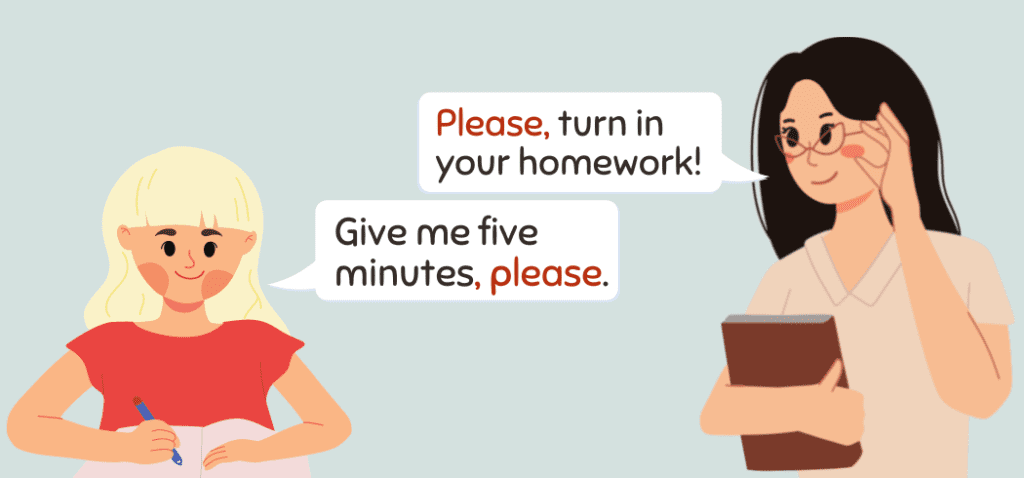We all use “please” to add a degree of politeness to our speech, but do you know how to punctuate it? Some people use it with a comma, and some do not, but which way is correct?
Actually, both depend on how you use it and what emphasis you want to place on it. The word please also has more than one part of speech associated with it, so knowing how to use it correctly can dictate whether you need to use a comma or not.
Let’s take a closer look at these simple rules to help you express yourself in writing the right way!
What Does Please Mean in a Sentence?

Please can be used in one of three different ways in a sentence. It can be used as an adverb, an interjection, or a verb.
As an adverb, you can use please to make a polite request, create an affirmative response, or express annoyance or impatience. It also works as an interjection in this form to help express the strong emotions of the speaker.
For example:
- May I please have a piece of cake?
- Yes, please! I absolutely would love to be part of your play!
- Oh please! You cannot be serious!
Verbs are action words, and you can use the word please to show a desire or will, as well as a way to provide happiness or satisfaction.
For example:
- If you don’t want to take my advice, just do what you please.
- The amount of research he did was very pleasing to the professor, allowing him to move forward with the publication earlier than expected.
Using Commas to Emphasize (and Other General Rules)
There are quite a few grammar rules associated with comma usage. We only need to consider some basic guidelines when please is used in a sentence.
Rule #1: Use a Comma After Introductory Words, Phrases, and Clauses
Commas are usually placed after a word, phrase, or dependent clause introduces a sentence.
For example:
- Dawning in a shroud of fog, we were worried the day would stay cold and chilly.
- Driving home, we decided to take a detour and visit some close friends.
Rule #2: Use Commas to Offset Unnecessary Words and Phrases in Sentences
Commas are also used to offset unnecessary words, phrases, and clauses in a sentence. They add details and interest but are nonessential to the overall understanding of the sentence.
For example:
- The forecast, which we check every morning, called for afternoon rain.
Rule #3: Use Commas to Emphasize Words and Phrases in Sentences
Commas can also be used to emphasize a word or phrase. Although their placement is not grammatically necessary, they provide a brief pause to highlight the word or phrase that follows.
For example:
- The students were, once again, late to class.
- I’m sure they will show up, eventually.
Commas Before and After Please

Since “please” can be used in more than one way, how you use it helps determine whether you should use a comma with it. Its placement in a sentence is also important to provide you with options for emphasis and tone.
When Please Is at the Beginning of a Sentence
When please is placed at the beginning of a sentence, it DOES NOT require a comma unless you want to emphasize it for tone. Usually, this emphasis creates a tone of irritation or impatience.
For example:
- Please turn in your homework.
- Please, turn in your homework!
- Please let the dog out.
- Please, let the dog out!
When Please in the Middle of a Sentence
There are many instances that “please” may be placed in the middle of a sentence. The different ways you use it determine whether a comma should or should not be used or whether you have a choice to add emphasis.
As an Interjection
If please is placed in the middle of a sentence as an interjection, it DOES NOT require a comma unless you want to emphasize it for tone. Again, this use will hint at annoyance or irritation.
For example:
- Would you please make sure the front door is locked?
- I need you home, please, by dark.
As a Verb
When please is functioning as a verb, DO NOT use a comma with it.
For example:
- Be sure to tell your hosts how pleased you are to have been invited.
- It is very pleasing to see how many students graduated last year.
Following a Conjunction
When please follows a conjunction (such as and, or, but, and because), it DOES NOT require a comma unless you want to emphasize it. If you do choose to emphasize it, place the comma after it.
In this usage, it does not always suggest annoyance but rather the importance of the word.
For example:
- The essay is due by the third period, and please remember to put your name on it.
- The essay is due by the third period, and please, remember to put your name on it.
- I enjoy your late-night phone calls, but please don’t ring after 10 o’clock.
- I enjoy your late-night phone calls, but please, don’t ring after 10 o’clock.
To Begin a New Clause
When please begins a new clause after a dependent clause, DO place a comma before it. A comma is not required after please, but if you want to emphasize it further, you may add a comma.
For example:
- If you call, please make sure to ring after 10 o’clock.
- If you call, please, make sure to ring after 10 o’clock.
- When you turn your papers in, please make sure your name is on it.
- When you turn your papers in, please, make sure your name is on it.
When Please Is at the End of a Sentence
Depending on how you use please, it may require a comma when placed at the end of a sentence.
As an Interjection
When used as an interjection at the end of a sentence to ask a question, DO use a comma.
For example:
- Could you pass some pie, please?
- Would you move your car, please?
As Part of a Statement
If you use please at the end of a sentence as part of a statement, it DOES NOT require a comma unless you want to place more emphasis on it.
For example:
- I need you to move that car please.
- I need you to move that car, please.
As a Verb at the End of a Sentence
DO NOT use a comma if please is used as a verb at the end of a sentence.
- Do what you please.
- She always does as she pleases.
Let’s Review
The word “please” provides you with many ways to use it in a sentence. It can work as a term for good manners, annoyance, or to show action. How you use it and where you decide to place it allows you to choose when you may want to use a comma for emphasis.
